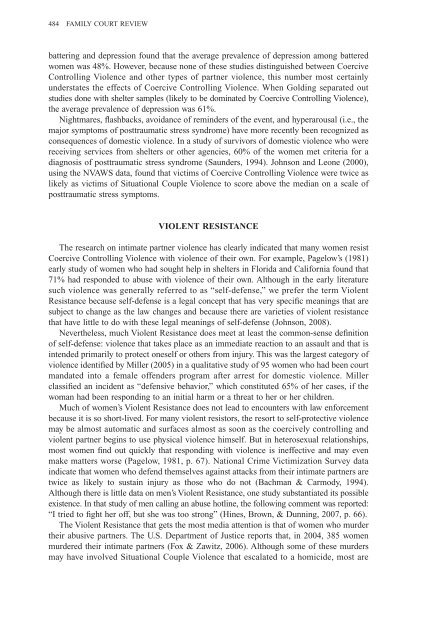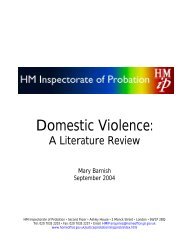differentiation among types of intimate partner violence - PAI Family ...
differentiation among types of intimate partner violence - PAI Family ...
differentiation among types of intimate partner violence - PAI Family ...
You also want an ePaper? Increase the reach of your titles
YUMPU automatically turns print PDFs into web optimized ePapers that Google loves.
484 FAMILY COURT REVIEW<br />
battering and depression found that the average prevalence <strong>of</strong> depression <strong>among</strong> battered<br />
women was 48%. However, because none <strong>of</strong> these studies distinguished between Coercive<br />
Controlling Violence and other <strong>types</strong> <strong>of</strong> <strong>partner</strong> <strong>violence</strong>, this number most certainly<br />
understates the effects <strong>of</strong> Coercive Controlling Violence. When Golding separated out<br />
studies done with shelter samples (likely to be dominated by Coercive Controlling Violence),<br />
the average prevalence <strong>of</strong> depression was 61%.<br />
Nightmares, flashbacks, avoidance <strong>of</strong> reminders <strong>of</strong> the event, and hyperarousal (i.e., the<br />
major symptoms <strong>of</strong> posttraumatic stress syndrome) have more recently been recognized as<br />
consequences <strong>of</strong> domestic <strong>violence</strong>. In a study <strong>of</strong> survivors <strong>of</strong> domestic <strong>violence</strong> who were<br />
receiving services from shelters or other agencies, 60% <strong>of</strong> the women met criteria for a<br />
diagnosis <strong>of</strong> posttraumatic stress syndrome (Saunders, 1994). Johnson and Leone (2000),<br />
using the NVAWS data, found that victims <strong>of</strong> Coercive Controlling Violence were twice as<br />
likely as victims <strong>of</strong> Situational Couple Violence to score above the median on a scale <strong>of</strong><br />
posttraumatic stress symptoms.<br />
VIOLENT RESISTANCE<br />
The research on <strong>intimate</strong> <strong>partner</strong> <strong>violence</strong> has clearly indicated that many women resist<br />
Coercive Controlling Violence with <strong>violence</strong> <strong>of</strong> their own. For example, Pagelow’s (1981)<br />
early study <strong>of</strong> women who had sought help in shelters in Florida and California found that<br />
71% had responded to abuse with <strong>violence</strong> <strong>of</strong> their own. Although in the early literature<br />
such <strong>violence</strong> was generally referred to as “self-defense,” we prefer the term Violent<br />
Resistance because self-defense is a legal concept that has very specific meanings that are<br />
subject to change as the law changes and because there are varieties <strong>of</strong> violent resistance<br />
that have little to do with these legal meanings <strong>of</strong> self-defense (Johnson, 2008).<br />
Nevertheless, much Violent Resistance does meet at least the common-sense definition<br />
<strong>of</strong> self-defense: <strong>violence</strong> that takes place as an immediate reaction to an assault and that is<br />
intended primarily to protect oneself or others from injury. This was the largest category <strong>of</strong><br />
<strong>violence</strong> identified by Miller (2005) in a qualitative study <strong>of</strong> 95 women who had been court<br />
mandated into a female <strong>of</strong>fenders program after arrest for domestic <strong>violence</strong>. Miller<br />
classified an incident as “defensive behavior,” which constituted 65% <strong>of</strong> her cases, if the<br />
woman had been responding to an initial harm or a threat to her or her children.<br />
Much <strong>of</strong> women’s Violent Resistance does not lead to encounters with law enforcement<br />
because it is so short-lived. For many violent resistors, the resort to self-protective <strong>violence</strong><br />
may be almost automatic and surfaces almost as soon as the coercively controlling and<br />
violent <strong>partner</strong> begins to use physical <strong>violence</strong> himself. But in heterosexual relationships,<br />
most women find out quickly that responding with <strong>violence</strong> is ineffective and may even<br />
make matters worse (Pagelow, 1981, p. 67). National Crime Victimization Survey data<br />
indicate that women who defend themselves against attacks from their <strong>intimate</strong> <strong>partner</strong>s are<br />
twice as likely to sustain injury as those who do not (Bachman & Carmody, 1994).<br />
Although there is little data on men’s Violent Resistance, one study substantiated its possible<br />
existence. In that study <strong>of</strong> men calling an abuse hotline, the following comment was reported:<br />
“I tried to fight her <strong>of</strong>f, but she was too strong” (Hines, Brown, & Dunning, 2007, p. 66).<br />
The Violent Resistance that gets the most media attention is that <strong>of</strong> women who murder<br />
their abusive <strong>partner</strong>s. The U.S. Department <strong>of</strong> Justice reports that, in 2004, 385 women<br />
murdered their <strong>intimate</strong> <strong>partner</strong>s (Fox & Zawitz, 2006). Although some <strong>of</strong> these murders<br />
may have involved Situational Couple Violence that escalated to a homicide, most are



